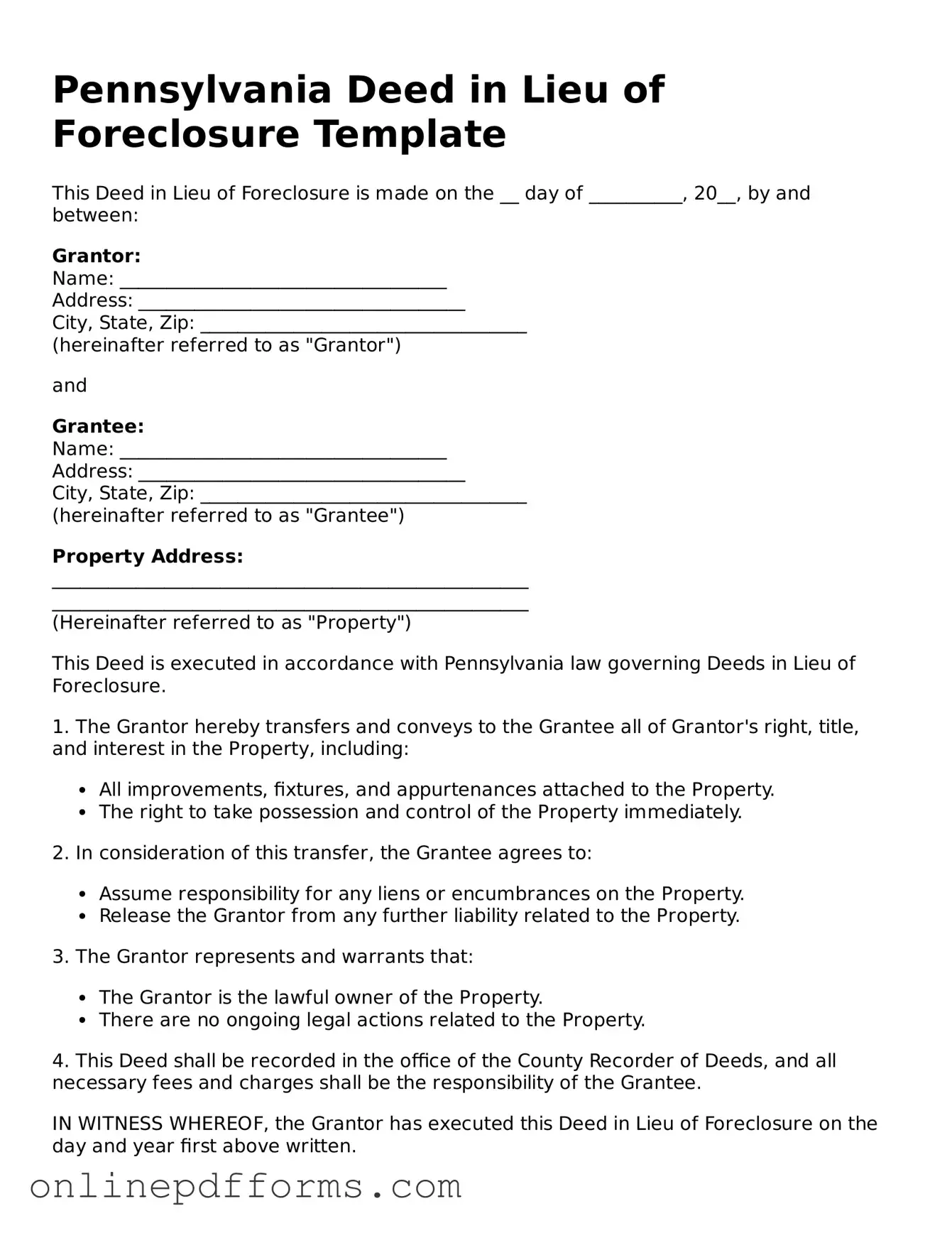The Pennsylvania Deed in Lieu of Foreclosure form shares similarities with a traditional mortgage release. In both situations, the borrower relinquishes their interest in the property to the lender. The mortgage release, however, typically occurs after the borrower has paid off the loan, while the deed in lieu allows for a transfer of ownership to the lender when the borrower is unable to meet their mortgage obligations. This process can help avoid the lengthy and costly foreclosure process, providing a more amicable resolution for both parties.
Another document that resembles the Deed in Lieu of Foreclosure is the short sale agreement. A short sale occurs when a homeowner sells their property for less than the amount owed on the mortgage, with the lender's approval. Like a deed in lieu, a short sale aims to mitigate losses for the lender and provide a way for the homeowner to exit their mortgage obligations. However, in a short sale, the homeowner still retains some control over the sale process, unlike in a deed in lieu, where ownership is directly transferred to the lender.
The loan modification agreement is also comparable to the Deed in Lieu of Foreclosure. In a loan modification, the terms of the original mortgage are altered to make the payments more manageable for the borrower. This can involve lowering the interest rate, extending the loan term, or even reducing the principal balance. While a deed in lieu results in the transfer of property ownership, a loan modification allows the borrower to keep their home by making it more affordable to continue making payments.
Another related document is the forbearance agreement. This is a temporary arrangement between the borrower and lender that allows the borrower to pause or reduce their mortgage payments for a specified period. Similar to a deed in lieu, the goal is to help the borrower avoid foreclosure. However, unlike a deed in lieu, the borrower retains ownership of the property during the forbearance period, with the expectation that they will resume regular payments once their financial situation improves.
The bankruptcy filing is also relevant when discussing alternatives to foreclosure. When a homeowner files for bankruptcy, it can halt foreclosure proceedings and provide the borrower with an opportunity to reorganize their debts. While a deed in lieu results in the homeowner losing their property, bankruptcy may allow the homeowner to keep their home while negotiating new payment terms. Both options aim to provide relief, but they do so in different ways and with different implications for property ownership.
A quitclaim deed is another document that bears similarities to the Deed in Lieu of Foreclosure. A quitclaim deed allows a property owner to transfer their interest in a property to another party without any guarantees regarding the title. This can be used in various situations, including transferring property to a family member or in divorce settlements. While a quitclaim deed does not specifically address mortgage obligations, it can facilitate the transfer of property ownership, much like a deed in lieu, although without the involvement of a lender.
The property settlement agreement, often used in divorce cases, also shares some characteristics with the Deed in Lieu of Foreclosure. In a property settlement agreement, spouses agree on how to divide their assets, including real estate. If one spouse is unable to keep the home, they may agree to transfer their interest to the other spouse or sell the property. Like a deed in lieu, this agreement can help resolve ownership issues, but it does not involve a lender's approval or address mortgage obligations directly.
The release of lien document is another similar form. This document is used to remove a lien from a property, typically after a debt has been paid off. In a deed in lieu situation, the lender may agree to release the borrower from the mortgage lien in exchange for the property. While the release of lien focuses on clearing the title, the deed in lieu involves the actual transfer of property ownership, making it a more comprehensive solution for addressing mortgage defaults.
When navigating the complexities of buying or selling any vehicle, including recreational vehicles in Texas, it's crucial to have the proper documentation in place to protect both parties involved in the transaction. One essential document that should not be overlooked is the https://pdftemplates.info/texas-rv-bill-of-sale-form/, which serves to formally record the details of the sale and ensure that ownership is transferred legally and effectively.
Lastly, the foreclosure notice is a document that is often the precursor to a deed in lieu. When a borrower falls behind on mortgage payments, the lender may issue a foreclosure notice, indicating the intent to begin foreclosure proceedings. This notice serves as a warning to the borrower and can prompt them to seek alternatives, such as a deed in lieu. Both documents address the issue of mortgage default, but while a foreclosure notice signifies the start of a legal process, a deed in lieu represents a voluntary resolution between the borrower and lender.
